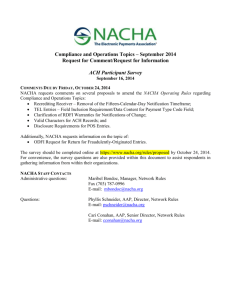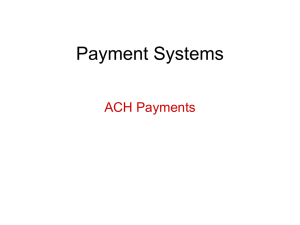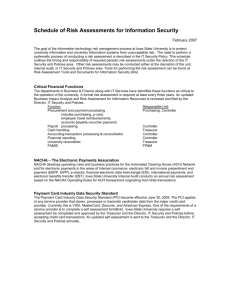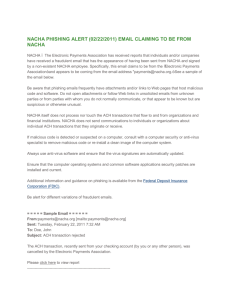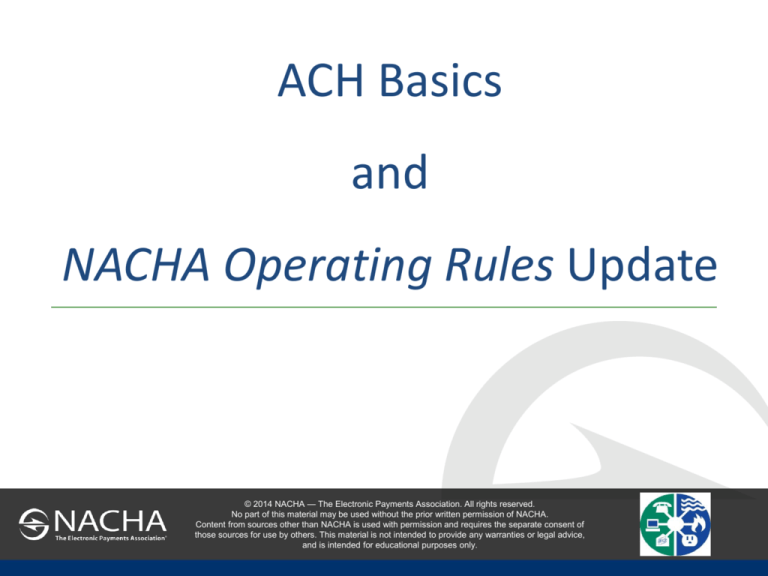
ACH Basics
and
NACHA Operating Rules Update
© 2014 NACHA — The Electronic Payments Association. All rights reserved.
No part of this material may be used without the prior written permission of NACHA.
Content from sources other than NACHA is used with permission and requires the separate consent of
those sources for use by others. This material is not intended to provide any warranties or legal advice,
and is intended for educational purposes only.
2
Agenda
• ACH Basics
• What’s New in the ACH Network
• ACH Under Development
3
What is NACHA?
Industry
Association
ACH Network
Administrator
NACHA
4
What is ACH?
• Automated Clearing House
– “Processing and delivery system that provides for the distribution and
settlement of electronic debits and credits among financial institutions”
• Batch-oriented, store-and-forward processing system
• Safe, secure, electronic network for consumer, business,
and government payments
• Used by more than 12,000 participating Financial
Institutions and millions of business and consumers
5
Facts about the ACH Network
• Over 22 billion transactions in 2013
• Payments valued at more than $39 trillion dollars in 2013
• 90% of total dollar value of all non-wire electronic
payments in the U.S. are supported by the ACH Network
• The ACH Network is governed by the fair and equitable
NACHA Operating Rules, which guide risk management
and create payment certainty for all players.
6
Foundation of the NACHA Operating Rules is
Contract Law
•
•
•
Originating Depository Financial Institutions (ODFIs) and Receiving
Depository Financial Institutions (RDFIs) are bound collectively to each
other by the Rules, as a multilateral agreement
The Rules assign ODFIs and RDFIs distinct roles, responsibilities, and
liabilities for ACH transactions that they originate and receive that flow
via warranties and indemnification to all other DFIs and ACH Operators
in the ACH Network
The NACHA Operating Rules require ODFIs and RDFIs to execute
agreements with Originators and third-parties, as applicable, that bind
them to the Rules
– Rules require Originators to have a relationship with Receivers (agreement or
authorization)
•
Additional Legal Requirements and Regulations (e.g., Regulation E)
create the framework for ACH transactions
7
Who are the Participants?
•
•
•
•
•
Originator
Originating Depository Financial Institution (ODFI)
ACH Operator
Receiving Depository Financial Institution (RDFI)
Receiver
8
ACH Credit Payment: Entry and Funds Flow
Authorization
9
ACH Debit Payment: Entry and Funds Flow
Authorization
10
Direct Deposit via ACH
• The deposit of funds
for payroll, T&E,
government benefits,
tax and other refunds,
and annuities and
interest payments.
11
Direct Payment via ACH
• The use of funds for making a payment.
• Individuals or organizations can send or receive a Direct
Payment.
• May be ACH credit or debit.
12
Role of Originators
Obligations of Originators
• Authorization must:
– Be readily identifiable, have clear and readily
understandable terms, provide that Receiver may revoke
only by notifying Originator in manner specified
• Debit entries to consumer accounts
– Notice of change in amount
– Notice of change in scheduled date
– Copy of debit authorization
13
Role of Originators
Obligations of Originators
• Record of authorization
– Originator must retain original or copy of authorization for
defined period of time
– Upon RDFI request, Originator must provide to ODFI copy
of authorization so that ODFI can provide to RDFI within
10 banking days
• Some applications (SEC Codes) have specific
requirements for Originators
14
Recent and Upcoming Implementations
• Prenotification Entries – Reduction in Waiting Period for
Live Entries – September 2014
• Proof of Authorization for Non-Consumer Entries –
September 2014
• Return Fee Entry Formatting Requirements – January
2015
• Dishonored Returns and Contested Dishonored Returns
Related to an Unintended Credit to a Receiver – March
2015
• Standards for Reinitiation of Returned Entries –
September 2015
15
Prenotification Entries – Reduction in Waiting Period for
Live Entries
•
•
•
•
Approved September 9, 2013; Effective September 19, 2014
Reduces the current Prenotification waiting period from six to three banking
days
If the ODFI receives a Return Entry or a Notification of Change in response
to the Prenote by the opening of business on the second Banking Day
following the Settlement Date of the Prenotification (that is, a timely return
or NOC), the Originator is not permitted to transmit subsequent Entries to
the Receiver’s account until it has remedied the reason for the Return Entry
or made the correction
If an untimely NOC in response to a Prenote is received by the ODFI
beyond the second banking day deadline, the Originator is required to make
the correction requested in the NOC within six banking days or prior to
initiating a subsequent Entry to the Receiver’s account, whichever is later.
16
Proof of Authorization for Non-Consumer Entries
•
•
•
•
•
Approved March 7, 2013; Effective September 19, 2014
Permits an RDFI to request proof of a Non-Consumer Receiver’s
authorization for a CCD, CTX, or an Inbound IAT Entry; and
requires that, upon receipt of an RDFI’s written request, the ODFI provide
either
– (1) an accurate record evidencing the Receiver’s authorization, or
– (2) the Originator’s contact information that, at a minimum, includes (i)
the Originator’s name, and (ii) Originator’s phone number or email
address for inquiries regarding authorization of Entries.
The record or information must be provided to the RDFI within ten banking
days without charge.
This change facilitates the investigation and resolution of disputes over
unauthorized Entries between entities with no relationship
17
Return Fee Entry Formatting Requirements
•
•
•
Approved August 22, 2014; Effective January 1, 2015
Revises the formatting requirements for certain Return Fee Entries to align
with the formatting requirements specific to the underlying transaction to
which the return fee relates
Return Fee Entry Formatting Requirements
– Clarifies contents of Individual Name field for PPD Return Fee Entries
authorized by notice, where Receiver name may not be readily available
to Originator
– May contain the Receiver’s name or a reference number, identification
number, or code that the merchant uses to identify a particular
transaction or customer
– Aligns field content with underlying ARC, BOC, POP entry to which the
fee relates
Dishonored Returns and Contested Dishonored Returns
Related to an Unintended Credit to a Receiver
•
•
•
•
•
•
Approved March 7, 2013; Effective March 20, 2015
Provides an Originator/ODFI with an additional mechanism to resolve, via the automated return process, situations
in which use of the reversal process has resulted in, or not resolved, an unintended credit to the Receiver
Unintended credits to the Receiver may be caused by either of the following conditions:
– A debit Erroneous Entry and a subsequent credit Reversing Entry are both transmitted to the Receiver’s
account. The erroneous debit is returned, but the reversing credit is posted and made available to the
Receiver.
– A credit Erroneous Entry and a subsequent debit Reversing Entry are both transmitted to the Receiver’s
account. The erroneous credit is posted and made available to the Receiver, but the reversing debit is
returned
ODFIs can now dishonor the Return of either debit (the erroneous debit or the Reversal), using new Return
Reason Code R62, provided that the associated credit Entry (the Reversal or the erroneous credit) was not also
returned by the RDFI
Requires any ODFI dishonoring a Return because the Reversal process either resulted in, or failed to resolve, an
unintentional credit to the Receiver to warrant that it originated a Reversal in an effort to correct the original,
erroneous transaction
Establishes the right of an RDFI to contest this type of dishonored Return, using new Return Reason Code R77, if
either of the following conditions exists:
– the RDFI returned both the Erroneous Entry and the related Reversal; or
– the RDFI is unable to recover the funds from the Receiver
18
19
Standards for Reinitiation of Returned Entries
•
•
•
•
•
Approved August 22, 2014; Effective September 18, 2015
Requires a reinitiated Entry to contain identical content in the following
fields: Company Name, Company ID, and Amount
Permits modification to other fields only to the extent necessary to correct
an error or facilitate processing of an Entry.
– This change will allow reinitiations to correct administrative errors, but
would prohibit reinitiation of Entries that may be attempts to evade the
limitation on the reinitiation of returned Entries by varying the content of
the Entry
Requires the word “RETRY PMT” be included in the Company Entry
Description field to identify Entries that are permissible resubmissions of
Returned Entries
Allows the use of Return Code R10 for violations of the Reinitiation Rule
20
Recent & Upcoming Implementations
• For more information, visit:
https://www.nacha.org/rules/updates
21
ACH Under Development
Upcoming Request for Comment
• Same Day ACH Concept
– Multiple Batch Transmission
– Additional Settlement Times
22
Same Day ACH Settlement – Phased
Implementation Concept
1
ACH Credits
AM & PM
Transmissions
5 PM ET
Settlement
2
ACH Credits
and Debits
AM & PM
Transmissions
5 PM ET
Settlement
3
ACH Credits
and Debits
AM & PM
Transmissions
Mid-day & 5 PM ET
Settlement
Faster Funds
Availability
Builds functionality over time, adding value to end-users with each step
23
Same Day Settlement
• Expedited Bill Payments
• Biller Scenarios
–
–
–
–
Allow consumers to pay bill on day it is due
Collect non-time sensitive bill payments faster
Faster funds collection for late payments
Bank’s online bill pay service could allow same day bill
payment
24
Same Day Settlement
• Other Corporate Uses of Same Day ACH
– Payroll Direct Deposits
– Internal cash concentration
– Accounts Payable and Receivable
25
Same Day ACH
• Request for Comment to be issued soon
• To add your comments, visit:
https://www.nacha.org/rules/proposed
26
Resources
• NACHA Operating Rules
• NACHA Operating Guidelines
– Do not supersede the Rules, but provide additional information
• ACH Rules Online
– Rules and Guidelines online access
– With full-featured search, bookmarking, and save search
– achrulesonline.org
• nacha.org
–
–
–
–
Upcoming amendments
Proposed changes
eStore
News and education
27
QUESTIONS?
Danita Tyrrell, AAP
Director of Network Rules
NACHA
dtyrrell@nacha.org
28
Appendix
Glossary
•
•
•
•
•
•
Return Entry: an Entry initiated by the RDFI to return to the ODFI a previously
initiated debit or credit Entry
Dishonored Return: a Return Entry that the ODFI sends back to the RDFI due to
defect or other limited condition
Contested Dishonored Return: a dishonored Return Entry sent back to the ODFI
because the RDFI either has corrected or disputed the reason for the dishonored
Entry
Prenotification Entry: a non-dollar Entry sent to the RDFI as notice that live Entries
will follow and as verification/validation of the account number
Return Fee Entry: an Entry initiated to collect a Return Fee
SEC Codes: a three-character code that identifies the ACH application used to
originate an Entry

